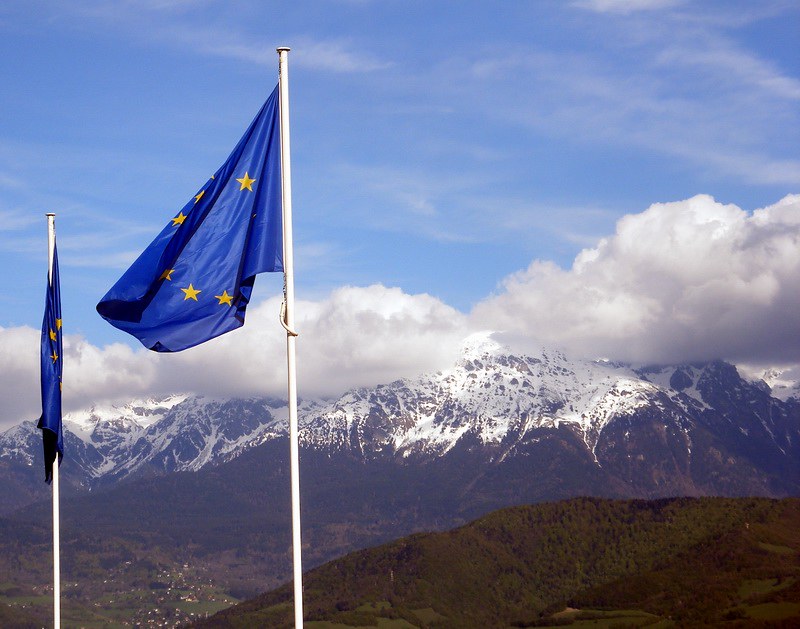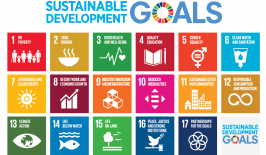In September 2015, the United Nations set out its 17 Global Goals for Sustainable Development. These goals, or SDGs (Sustainable Development Goals) are the backbone of the 2030 Agenda for Sustainable Development which aims to “secure sustainable development at the economic, social and ecological levels”, as a UN resolution states. Over the next fifteen years, countries all around the worls are to use these goals as a guideline and mobilise efforts to end poverts in all its forms, fight inequalities and tackle climate change – while at the same time ensuring that no one is left behind.
RESET has already examined the 17 SDGs in more detail and what they set out to do. Now, almost four years after they were adopted, the EU has institutionalised the goals, often turning them into concrete, real-life policies and it’s time to take a look at the current situation: What measures has the EU taken to achieve the SDGs? Where are improvements needed? And how can the goals finally be achieved?
The 17 SDGs are all interdependent: The achievement of one goal depends on the other goals also being achieved. And they’re equally crucial too, meaning they can’t be ranked in order of importance. Because RESET’s focus is sustainable innovation first and foremost, there are three of the 17 goals that we find particularly interesting: Clean Energy (SDG 7); Industry, Innovation and Infrastructure (SDG 9) and Responsible Consumption and Production (SDG 12).
Clean Energy: Is Europe a Green Energy Pioneer?
Goal 7 aims to achieve access to affordable and clean energy for everyone. The EU is already one of the most carbon-efficient economies in the world. Renewable energy is a central component of the EU’s energy mix: more than half of the electricity supplied in the EU is generated in a climate-neutral way. And the EU is continuously improving the situation by introducing various energy efficiency measures. The “Energy Union Strategy” is a project launched by the European Commission in 2015 with the goal of giving EU consumers secure, sustainable and affordable energy – while fundamentally transforming Europe’s energy system. This launch established one of the largest legal frameworks in the world for energy system transformation and economic modernisation, where climate, energy and research policy were all combined. The EU wants to improve its share of renewable energies to be at least 32 percent of total energy consumption by 2030. And in addition, the Paris Agreement set the target of reducing greenhouse gas emissions by at least 40 percent compared to 1990. The EU is also seen as a pioneer in marine energy and offshore wind energy technologies.
Despite all of this though, there is still a lot of room for improvement. Although it comprises only around 7 percent of the world population, the EU consumes about one fifth of the world’s energy. We actually end up having to import more than half of the energy that we use. There’s not enough renewable energy being produced and there’s a drastic lack of investment: right now the EU needs approximately 180 billion euro in extra investment every year until 2030 in energy efficiency, renewable energy, and clean transportation.
Buildings, which are responsible for around 40 percent of energy consumption and 36 percent of CO2 emissions, are particularly problematic in the densely-populated EU region. The European Commission recognized this issue in a recent reflection paper. In 2018, the “Energy Performance in Buildings Directive” was passed, aiming to decarbonise buildings by 2050. However, it mainly covers new buildings, while in fact it’s old buildings that are the most critical and the most effective place to start: About 35 percent of buildings in the EU are at least 50 years old and about 75 percent of all buildings are energy inefficient. Although renovations could reduce the EU’s energy consumption by 5 to 6 percent and reduce CO2 emissions by around 5 percent, only 0.4 to 1.2 percent of buildings are renovated each year.
Promoting sustainable infrastructure and innovation
Goal 9 focuses on building resilient infrastructure, promoting inclusive and sustainable industrialization and fostering innovation. Alongside irrigation, energy and information and communication technology, the transport sector is one central component of our infrastructure. Transport accounts for almost a quarter of Europe’s greenhouse gas emissions and is the main cause of urban air pollution. The EU has initiated different measures to improve our transport system including the European Strategy for Low-Emission Mobility in 2016 and three sets of measures under the name ‘Europe on the Move‘ in 2017 and 2018. A wide range of initiatives are set to make transport safer, promote smart toll systems and reduce emissions, air pollution and traffic congestion, among other things. The overriding goal at the end of all of these measures is a zero-emissions EU.
The latest ‘Europe on the Move’ measure aims to enable all people in Europe to benefit from safer transport, greener vehicles and innovative technological solutions. Europe plans to become a pioneer for fully-automated and networked mobility systems. However, when it comes to infrastructure and mobility, there too there is still a lot of room for improvement. The future of emissions-free road transport lies in e-mobility, which should be receiving much more support and funding than it currently is. It is also essential that electric vehicles are being charged with electricity from renewable sources and not the normal energy mix – that still primarily comes from burning fossil fuels. Trains in Europe, for example, are still largely powered using electricity that comes from coal and nuclear power. Environmentally harmful transportation such as air travel still receive funding, while the tax exemption for kerosene and the VAT exemption for international flights tends to make flying far cheaper than rail or other more environmentally-friendly means of transportation.
According to the Commission’s paper ‘Towards a Sustainable Europe by 2030’, the EU is the “most open research and innovation area in the world”. Europe accounts for 20 percent of global R&D investment and produces one third of all high quality scientific publications. Companies’ investments in research and innovation still currently lag behind China, the USA and Japan, however, reaching just 1.3 percent of GDP. And since the economic crisis of 2008, the number of patent applications has also stagnated. Digital transformations also need to be funded more than they currently are – because they form the basis of the transition to a low-carbon society and a circular economy.
How sustainable is production and consumption in Europe?
The EU and its member states are doing particularly badly when it comes to goal number 12: Responsible Consumption and Production. Traditional, conservative patterns of consumption and production still dominate throughout Europe. Laws and regulations are changing very slowly and often, unsustainable sectors and areas are hinder progress because they’re worried about losing their traditional sources of income and having to reorient themselves – a problem which is closely linked to a general lack of financial incentives available for the kind of reorientation that is required.
Transitioning to a circular economy is crucial if SDG number 12 is ever to be achieved. In 2015, the EU Commission presented an EU action plan for the circular economy, which has the potential to speed up progress. The plan has already resulted in a faster transition from a linear to a circular economy and created new jobs. But there has also been criticism: there’s still a lot that has to be done before the cycle is completely closed and it’s possible to make the most of the competitive advantages that the circular economy offers to EU businesses. Right now, we are currently still far away from achieving the goals that have been set. A Europe-wide circular economy is still nowhere in sight.
The European Commission also recently adopted a Europe-wide strategy on plastics with the aim to “protect the environment from plastic pollution whilst fostering growth and innovation”. This strategy is the first ever EU-wide policy framework that focusses on the lifecycle of just one specific material. It aims to enable circular product design and to integrate recycling into plastic supply chains. By 2030, all new plastic packaging on the market must be reusable or recyclable. Microplastics and the most harmful disposable plastic articles, for which alternatives already exist, are to be banned. Between 2016 and 2020, the EU will provide a total of more than ten billion euros in public funding for innovation and investment. The Ecodesign Working Plan was released in 2016, a legislative framework that aims to increase the amount of energy-efficient products that come to the market, promote products that can be used in a circular way and encourage consumers to buy the most efficient products based on useful information (like through energy-efficiency labelling). These measures demonstrate that there is a political will to ensure positive development in this area. However, much more effort is needed to achieve SDG 12. Currently, less than 12 percent of the materials used in the EU are part of the circular economy. This figure is far too low for us to be able to achieve the targets we have set ourselves by 2030. Not to forget the fact that the EU recycles only around 30 percent of the plastic waste that it generates. More efficient measures are needed, not just good will.
Another crucial sector of consumption and production is the food industry. The EU-wide trend is promising: since 1990, greenhouse gas emissions from agriculture have fallen by 20 percent and the nitrate content of rivers by 18 percent. In addition, organic farming in the EU member states has grown steadily since 2005. But the major challenges have not yet been met. The Common Agricultural Policy of the EU does not have high environmental ambitions and is unlikely to improve the situation significantly. Export-oriented agriculture and the excessive consumption of animal products continue to compound environmental problems. Food production and consumption must therefore change fundamentally. Effective incentives have not (yet) been set.
Summing up: We’re on the right track, but there’s so much more to be done
The EU has already taken meaningful steps in many areas in order to achieve its goals and foster sustainable development, while in other areas there is still considerable room for improvement. In general, it could be said that while the EU often sets out ambitious plans, what often follows is a lack of practical implementation, incentives and/or sanctions. And – quite rightly too – those ineffective commitments often come in for criticism.
If the EU is to make real progress then everyone needs to work together. Working closely with the scientific community, policy-makers need to draw up comprehensive and binding laws, legislations and policies which are then implemented by businesses and consumers. Only then can the EU achieve its sustainability goals – and make a meaningful contribution to ensuring a futureproof world for all.
Author: Keno Röller-Siedenburg, RESET Editorial (July 2019)
Translated by Marisa Pettit (July 2019)








